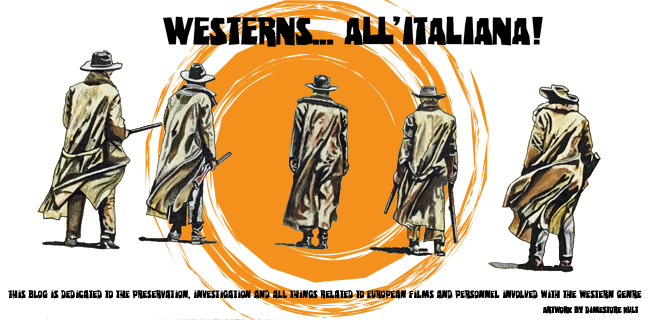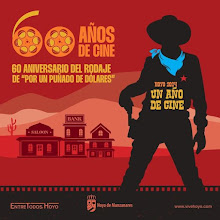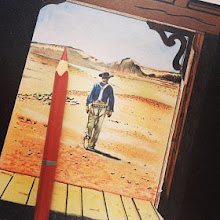Anthony Ghidra Double Feature.
Wild East, USA. Format NTSC Region 0.
Anthony Ghidra only made a handful of Spaghetti Westerns but he's now fairly well known amongst genre fans thanks to Wild East's earlier DVD releases of
Pistoleros and
Django the Last Killer. Both films were low budget but entertaining genre entries in which Ghidra managed to make something of an impression. It's great to report that Ghidra makes an even bigger impression in the two surprisingly good films featured on this new double bill disc,
Tequila Joe and
A Hole Between the Eyes. Indeed, the overall quality of the two films presented here make this one of Wild East's most significant releases yet.
Tequila Joe Directed by Vincent Eagle. 1968. Widescreen (1.85: 1 anamorphic). 91 minutes.
A sharp-shooting young stranger, Burt (Jean Sobieski), arrives in a troubled town and tells the drunken sheriff, Tequila Joe (Anthony Ghidra), that he's his new deputy. Joe is a broken man who has lost his nerve and his inclination to uphold the law: he's quite happy to simply get drunk and live a quiet life while the vicious gangs that are controlled by two rival bad guys, Trianas (Furio Meniconi) and Mulligan (Dick Palmer), cause murderous mayhem around town. Burt sets about forcing Joe to clean up his act and when Joe witnesses the bloody aftermath of one of Trianas and Mulligan's violent shootouts he starts making an effort to pull himself together. However, Trianas and Mulligan both refuse to curb their unlawful activities and pressure from Burt ensures that local tensions escalate to a point where Joe is finally forced to take action.
This is a middle to lower tier genre entry but it's a great little film that largely manages to transcend the limitations of its budget. It features a fairly standard mix of generic elements (the town held under siege by rival gangs, the stranger guided by mysterious motivations, the broken lawman, etc) but it mixes them up in a pleasing and thoroughly entertaining way. This is an action-packed show and, towards its end, the film features some pretty wild and unexpected narrative twists that lead into an exciting finale. There are some quite stylishly staged scenes present here and director Vincent Eagle's (AKA Enzo Dell'Aquila) consistently sure-handed approach works just fine. The show features a number of familiar faces and the quality of the acting on display is pretty good for the most part. Anthony Ghidra provides one of the best performances seen in a Spaghetti Western, period. He is completely convincing as the self-pitying and hopelessly drunk lawman and his quite brilliant performance brings a lot of depth to the character of Joe. When the details of the tragedy that prompted Joe to hit the bottle are revealed, Eagle forgoes a flashback and simply lets Joe relate his dramatic backstory to Burt verbally. It's a testament to the quality of Ghidra's acting in this show that this scene works so well. Francesco De Masi's soundtrack score isn't his best work but it gets the job done well enough. Picture quality here is just about excellent: there's next to nothing in the way of scratches or print damage. The presentation's sound quality is pretty good too.
Extras: image gallery, English trailer and Italian trailer.
A Hole Between the Eyes Directed by Joseph Warren. 1968. Widescreen (2.35: 1 anamorphic). 85 minutes.
Bounty killer Bill Blood (Anthony Ghidra) is tracking down three Mexican bandits who each hold a very special playing card. When the three playing cards are brought together, the cryptic writing scrawled on each one of them will reveal the whereabouts of the $100,000 in gold that the three Mexicans stole from General de Santa Anna's army. Having secured one of the cards, Blood next sets about getting the card that belongs to a fearsome and ruthless bandit leader, General Munguya (Robert Hundar). However, things get complicated when the holder of the third card, Garrincha (Luigi Marturano), teams up with an unscrupulous businessman, Tedder (Giorgio Gargiullo), and the pair devise a plan that has the potential to cause both Blood and Munguya a whole lot of trouble.
The big news here is that this hitherto little-seen film actually looks and plays like an expensive A grade Spaghetti Western for much of its runtime. It's a little unusual in as much as it is set in unfamiliar locations and features few familiar faces. The lack of big name acting talent suggests that the film perhaps had a medium-sized budget at best. However, the show's production values are really top notch and it remains a great-looking film that compares well visually to the genre's best entries. Stylish cinematography and impressive set designs and costumes that feature lots of finely observed details help this show to punch well above its own weight. The quality of the film's acting is very good and the show features an abundance of interesting characters who deliver some fantastic dialogue. Roberto Pregadio's beautiful soundtrack score -- which sounds a bit like Procol Harum playing excerpts from Ennio Morricone's score for
The Grand Silence in places -- is also quite unusual but excellent. The show's writer Adriano Bolzoni helped to script some great Spaghetti Westerns and he continues his good work here by adding an original and refreshing spin to the genre's now familiar "hunt for a hidden treasure" narrative variant. The film is quite short at 85 minutes but it is perfectly paced. There are so many moments of intrigue and so many well executed set pieces present here that the film has the feel of a longer, more epic-like production. If you're a Spaghetti Western fan and you haven't seen this show yet, you're in for a real treat as the film surely rates as one of the best genre entries of the late 1960s. For an obscure film the picture quality here is pretty good for the most part. There are odd outbreaks of scratches and the like present from time to time but these don't pose a major problem. The presentation's sound quality is a little flat in places but, again, this isn't a major problem.
Extras: image gallery and German trailer.
© 2011 Copyright Lee Broughton.











No comments:
Post a Comment